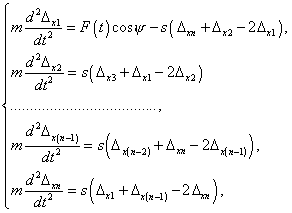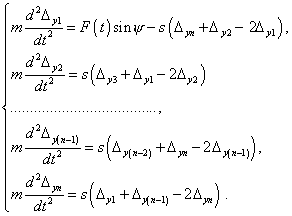| SELF | 92 |
| S.B. Karavashkin, O.N. Karavashkina | |
|
|
These transformations of the
vibration pattern can be simply explained by the regularities of transformation from the (x,
y) reference system to that ( On the basis of Fig. 1 construction, the transfer conditions between the reference systems take the form |
|
|
(16) |
Substituting, for example, (10) and (11) into (16), we yield: for the |
|
|
(17) |
and for the |
|
|
(18) |
We can see from (17) and (18) that with the positive The considered example shows that despite the bend angle does not effect on the solutions, in the specific elastic line models their own distinctions arise that are caused by the regularities of coordinate systems transformation before and after the bend point. 4. Closed-loop homogeneous elastic lumped systemConsider a closed-loop homogeneous line consisting of n elements connected by means of elastic linear constraints having equal transverse and longitudinal stiffnesses; its general form is presented in Fig. 6a. According to the proven theorem, this line can be presented as a linear chain whose first mass is rigidly connected with the nth elastic constraint, just as it is shown in Fig. 6b. The modelling system of differential equations for this line is following: |
|
Fig. 6. The calculation scheme of a homogeneous
closed-loop elastic line consisting of n elements under the harmonic force F
(t) acting with the angle
|
|
| for the x-component | |
|
(19) |
and for the y-component |
|
|
(20) |
As opposite to (8)-(9), the systems
of modelling equations (19)-(20) are finite, and the first and last equations of the
systems (19)-(20) are connected by the cross relation through the parameters |
|



